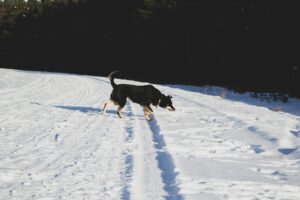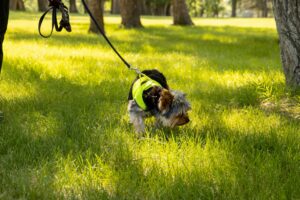Barks Blog
Scent Success: Giving Scent Work a Second Chance
Congratulations to Shelley Doane! This post won runner up in the 2022 Canine Scent Writing Competition.
I started getting interested in canine scent work with my dogs a few years ago. It began with an introductory class taught by a fellow trainer. It was an interesting class with lots of good information, but I did not find it fun, and my dog, Sophie, didn’t seem to really enjoy it either. A couple of years later, I listened to a podcast by another trainer about scent work using food and how she had found it both fun and engaging for her clients. (I believe she was even running competitions to see which dogs could find and retrieve the most treats, but don’t quote me on that.) This inspired me to give scent work another try, and I am glad I did. This time Sophie got excited in a way that I hadn’t seen in a long time. When she found treats in the old shoeboxes I was hiding them in, she slapped her paw on them. This is a dog that tapped so gently with her paw on the door to come inside that you had to listen intently to hear it. And now she was excited and engaged and ready to play. I knew I had to try this with my clients and their dogs.

My main clients at the time were pet owners taking an introductory class to teach their dogs basic manners, and new puppy owners wanting to get started on the right path in their relationship with their dogs. I offered scent work as something fun to do with their dogs. In the first class I taught, the owners laughed at their dogs’ eagerness and enjoyed playing with their dogs, and the dogs, well, they loved finding treats. Recently, I talked to a client from that first class, and she commented that since taking the class, she has been more aware of her dog’s body language and often notices when he is smelling something particularly interesting.
Today, any chance that I get to teach a scent class, I do, but now I include some reactive dogs. In a scent class, we don’t reach into the dog’s space, and we take away the social pressure to engage with people and other dogs—we just have fun. The owners are more relaxed and less worried that people are going to approach their dog and then their dog will react. When the owners are more relaxed, the dogs are calmer. Besides being fun, scent work also improves communication between dogs and their owners. Owners learn to read their dogs’ body language, paying closer attention to when their dogs get excited or find something, while dogs learn to communicate with their owners when they need help getting some of the jars and containers open.
To give you a sense of how this class goes, week one begins very simply with teaching a “find it” cue. We hide a treat in one fisted hand, then we hide treats in both hands, then we move to one container (a bucket), then two containers, and so on. The owners are taught to teach their dog a wait word and release word, so that later they can hide their own treats. Each week we make it harder by adding more and more containers. At a certain point, I approach the buckets and touch all of them, but hide a treat in only one, so the owners are not aware of where the treat is. Now they must rely on observing their dog. This is where the fun starts, and owners laugh at how clearly their dogs tell them where the treat is.
What the owners don’t know, and I don’t share, is that I deliberately place the buckets far enough away that their dog is okay when I approach and hide the treat. If a dog is particularly reactive, I will have the owner move the dog back when I approach, and then bring the dog forward as I move away after hiding the treat. I have used this same technique with leash-reactive dogs—teaching owners to move their dogs away as I move forward and place a treat on the ground, then I move away and they bring their dogs forward to find the treat, and then they move away, and so on—aiming for a calm, successful loop. (Note that my goal is not to get as close as I can to the dog.) This works wonders for dogs that won’t take treats from their owners.

I just wrapped up a four-week scent class. For the last class, I had the owners hide treat jars (jam jars with holes in the lids). They owners were instructed to walk a specific zigzag pattern along a path, and then come straight back along the edge of the path. The next step was for the owners to walk their dogs along the path to find the treat jars, but also to watch if their dogs followed their steps when they hid the treat jars. Most often, the dogs walked the same zigzag pattern that the owners had taken when hiding the treat jars. Now we have an introduction to tracking!
Shelley Doane is, first and foremost, a pet dog person with one older dog at home, having recently lost one of the sweetest dogs ever. Her main goal is to teach and work with people to help them and their dogs live better together. When she is not teaching, she is researching and writing about canine behavior.

